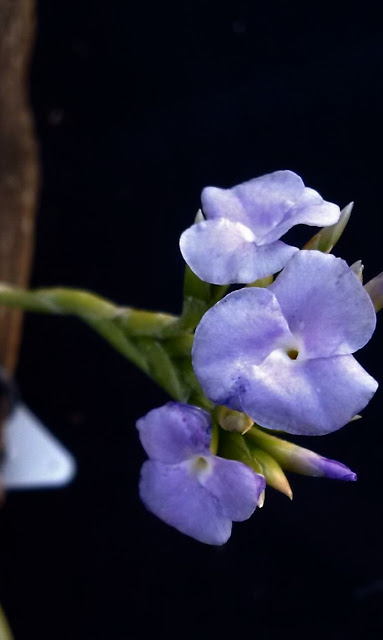As with the first definitionhese plantlets/pups appear on this Tillandsia species in large numbers, as well as in the axils of the subfoliate scape bracts, as well as in the axils of the sterile bracts of the stem-like section of the spike.
The two names in bold are recognized and also shows the recent name changes:
| Tillandsia secunda Sessé & Moç. => Pitcairnia palmeri var. palmeri | |||
| Tillandsia secunda Kunth | |||
| Tillandsia secunda sensu André => Tillandsia mima | |||
| Tillandsia secunda Sensu L.B.Sm. => Tillandsia cucullata | |||
| Tillandsia secunda var. major Rauh | |||
| Tillandsia secunda var. vivipara Rauh => Tillandsia secunda |
My plants would probably have been labeled Tillandsia secunda var. vivipara Rauh
The species grows as a terrestrial and on rocks and cliffs, 2000-3500 m alt, Ecuador.
The history of the plant.
The plant was bought in November 2017. The plant was growing well and cleaning it up a bit, I noticed it was planted in garden soil. I decided not to bother with repotting because it was doing well.This is the plant March 2018. I placed the plant in good light on a stand and it is growing very fast!
November 2018:
September 2019: The pot seems very small in relation with the plant now.
After each winter there seems to be some cold damage visible on the leaves as they grow out. Temperatures here can fall to 4 degrees Celsius in winter.
2 October 2019: Spring here and the first sign of a spike forming:
12 October 2019: Only 10 days passed and the spike is visible - incredible how fast they spike!
16 October 2019. The flower spike is growing out of the leaves.
27 October 2020. The plant was taken from the stand and placed on the floor. The spike was getting too long and I was worried about heat damage close to the roof. The first lateral spikes are visible.
23 November 2019:
5 January 2020. Flowers opened for the first time. The flowers and floral bracts are secund, meaning the hang down and most in the same direction.
On this plant the stigma extend beyond the petals. The anthers are just visible. Not all flowers opens as nicely as these ones did. (I do believe a lot of the flowers that did not open fully are going to be self pollinated - but only time will tell.)
Comparison of flowers with the one Ken Woods posted on bromeliad.org.au.
Did some pollinating. Will report on them if they develop.
Mostly used Tillandsia flabellata and Tillandsia capitat 'Rubra' as pollen parents.
6 January 2020. The first pup lower down is visible. Notice also the water in the "tank" of the plant. I believe that it holds more than a liter of water in the axils of the leaves, but I did not measure!
15 March 2020 - Pups galore! Some branches developed at the lowered bracts and up to three pups formed on them! At this stage no pups forming at the base.
This one from Trevor Brauckmann seems to be pupping from the base also:
Flowering and pups forming happens simultaneously. I do feed regularly and this probably boosted pups forming.
It seems that the plant is weaning some of the pups. They came loose only by touching them.
(I am thinking this is a way of the plant spreading- these smaller pups can be easily washed down a slope or even the wind blowing them around will disperse them away from the mother plant?)
The inflorescence 30 March 2020.
Growing conditions.
- LIGHT : My plant is grown in about 60-70% sunlight.
- HUMIDITY : Because it is grown under plastic and shade netting, the humidity in summer is quite high. In winter I rarely water, so the humidity is very low then.
- TEMPERATURES: Temperatures can go below 0 degrees Celsius, but it normally goes down to 4. In summer temperatures can go up to 40 degrees Celsius outside - inside it can go up to 43!
- Feeding: As frequently as possible using organics through the micro sprayers.
- Watering : Probably 2-3 times a week in summer early in the mornings. In winter very rarely and only on warmer days.
- Potting/Mounting etc.: My plant is potted in garden soil, but I do have others that is mounted or growing hanging in the air. The important thing is to keep the "tanks" filled with water or they will dehydrate if not potted up - especially in a dry climate like mine.
Marie Goosen
Marlene Astrid
Riette Theron






















































